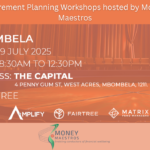The South African investment management industry has undergone significant changes over recent years, particularly in the retail sector. The emergence and growth of discretionary fund managers (DFMs) was one of the material changes driven by the regulatory and time burden placed on financial advisers who wish to deliver Category II discretionary fund management services. Not all DFM offerings are the same: Some manage only in-house funds, some specialise in specific areas, while others, like Equilibrium, offers the full spectrum of Category II services, including strategic and tactical asset allocation, manager research, strategy optimisation, portfolio construction, and investment reporting.
Like any investment management business, a DFM’s success will be determined by the ability to attract clients’ assets and deliver investment returns to retain these assets. Equilibrium has been able to successfully grow its market share over recent years, built on good investment outcomes as well as adding value to advice practices through investment and operational support of the advice process. This frees up advisers to spend more time in front of clients, which is to the benefit of all parties involved.
Tasked with delivering outcomes in line with client objectives, the portfolio managers in a DFM plays a very important role in an advice practice. Naturally, a trust relationship between the portfolio manager and the adviser or advisers is built over time. However, the loss of key individuals like portfolio managers can have a big impact on a DFM and may raise questions around the sustainability or continuity of the DFMs offering.
This is where the advantages of being part of a bigger group is clear to see. Although Equilibrium operates independently in terms of portfolio construction, it shares the Momentum Investments investment philosophy based on shared manager, economic and asset allocation research. This allows Equilibrium to access senior portfolio managers within Momentum Investments to step in and caretake the Equilibrium and bespoke client portfolios if and when required.
Equilibrium is built on a clearly defined and proven investment philosophy, and without deviating from this philosophy, the team can work through the portfolios and the process to ensure that we are well-positioned to continue to deliver good investment outcomes in a continually evolving investment landscape.
In this changing landscape Equilibrium can help advisers navigate questions like: How can actively managed certificates and exchange-traded funds be used in investment portfolios? Is the below-average long-term returns delivered by the local equity market cyclical or a structural shift in the opportunity set for the asset class? What is the impact of the increased offshore allowance for regulation 28 compliant portfolios on local asset classes and the investment industry? Does the steady increase in risk premium being priced into local asset prices offers a good buying opportunity, or is it just reflective of political uncertainty and lack of economic growth locally? How can alternative investments be used to enhance portfolio performance in a low-return environment globally?
The Equilibrium team is very confident in its abilities to navigate challenging and changing financial markets and build long-lasting and meaningful relationships with our clients.
At Equilibrium, we bring improved balance into your financial advice practice. To find out more about our discretionary fund management services and how we can enable your advice outcomes;
Equilibrium Investment Management (Pty) Ltd (Equilibrium) (Reg. No. 2007/018275/07) is an authorised financial services provider (FSP32726) and part of Momentum Metropolitan Holdings Limited, rated B-BBEE level 1.










